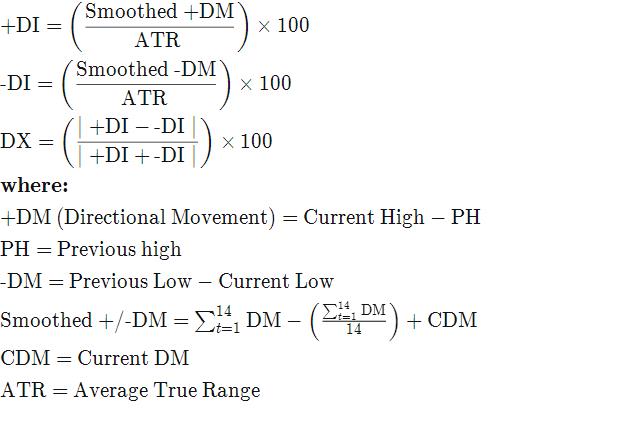Indicele mișcării direcționale (DMI)
Ce este indicele mișcării direcționale (DMI)?
Indicele mișcării direcționale (DMI) este un indicator dezvoltat de J. Welles Wilder în 1978, care identifică în ce direcție se mișcă prețul unui activ. Indicatorul face acest lucru comparând maxime și minime anterioare și trasând două linii: o linie de mișcare direcțională pozitivă (+ DI) și o linie de mișcare direcțională negativă (-DI). O a treia linie opțională, numită indicele direcțional mediu (ADX), poate fi, de asemenea, utilizată pentru a măsura puterea tendinței ascendente sau descendente.
Când + DI este peste -DI, există mai multă presiune ascendentă decât presiune descendentă în preț. În schimb, dacă -DI este peste + DI, atunci există o presiune mai scăzută asupra prețului. Acest indicator poate ajuta comercianții să evalueze direcția tendinței. Crossover-urile între linii sunt, de asemenea, uneori folosite ca semnale comerciale pentru cumpărare sau vânzare.
Chei de luat masa
- Indicele mișcării direcționale (DMI) este un indicator tehnic care măsoară atât puterea, cât și direcția unei mișcări de preț și este destinat să reducă semnalele false.
- DMI utilizează doi indicatori standard, unul negativ (-DM) și unul pozitiv (+ DN), împreună cu un al treilea, indicele direcțional mediu (ADX), care este nedirecțional, dar prezintă impuls.
- Cu cât diferența dintre cele două linii principale este mai mare, cu atât tendința prețurilor este mai puternică. Dacă + DI este mult peste -DI, tendința prețurilor este puternic în creștere. Dacă -DI este cu mult peste + DI, atunci tendința prețurilor este puternic în jos.
- ADX măsoară puterea tendinței, fie în sus, fie în jos; o lectură peste 25 indică o tendință puternică.
Formulele pentru indicele mișcării direcționale (DMI) sunt

Calculating the Directional Movement Index
- Calculate +DM, -DM, and the true range (TR) for each period. Typically 14 periods are used.
- +DM is the current high – previous high.
- -DM is the previous low – current low.
- Use +DM when the current high – previous high is greater than the previous low – current low. Use -DM when the previous low – current low is greater than the current high – previous high.
- The TR is the greater of the current high – current low, the current high – previous close, or the current low – previous close.
- Smooth the 14-period averages of +DM, -DM, and the TR. Below is the formula for TR. Insert the -DM and +DM values to calculate the smoothed averages of those as well.
- First 14TR = Sum of first 14 TR readings.
- Next 14TR value = First 14TR – (Prior 14TR/14) + Current TR
- Next, divide the smoothed +DM value by the smoothed average true range (ATR) value to get +DI. Multiply by 100.
- Divide the smoothed -DM value by the smoothed TR value to get -DI. Multiply by 100.
- The optional directional index (DX) is +DI minus -DI, divided by the sum of +DI and -DI (all absolute values). Multiply by 100.
- The average directional movement index (ADX) is a smoothed average of DX, and is another indicator that can be added to the DMI. To get the ADX, continue to calculate DX values for at least 14 periods. Then, smooth the results to get ADX.
What Does the Directional Movement Index Tell You
The DMI is primarily used to help assess trend direction and provide trade signals.
Crossovers are the main trade signals. A long trade is taken when the +DI crosses above the -DI and an uptrend could be underway. Meanwhile, a sell signal occurs when the +DI instead crosses below the -DI. In such cases, a short trade may be initiated because a downtrend might be underway.
While this method may produce some good signals, it will also produce some bad ones since a trend may not necessarily develop after entry.
The indicator can also be used as a trend or trade confirmation tool. If the +DI is well above -DI, the trend has strength on the upside, and this would help confirm current long trades or new long trade signals based on other entry methods. Conversely, if -DI is well above +DI, this confirms the strong downtrend or short positions.
The Directional Movement Index vs. the Aroon Indicator
The DMI indicator is composed of two lines, with an optional third line. The Aroon indicator also has two lines. The two indicators both show positive and negative movement, helping to identify trend direction.
The calculations are different, though, so crossovers on each of the indicators will occur at different times.
Limitations of the Directional Movement Index
The DMI is part of a larger system called the average directional movement index (ADX). The trend direction of DMI can be incorporated with the strength readings of the ADX. Readings above 20 on the ADX mean the price is trending strongly. Whether using ADX or not, the indicator is still prone to producing lots of false signals.
Notably, +DI and -DI readings and crossovers are based on historical prices and don’t necessarily reflect what will happen in the future. A crossover can occur, but the price may not respond, resulting in a losing trade.
The lines may also crisscross, resulting in multiple signals but no trend in the price. This can be somewhat avoided by only taking trades in the larger trend direction based on long-term price charts, or incorporating ADX readings to help isolate strong trends.